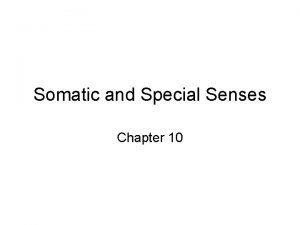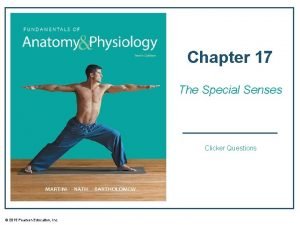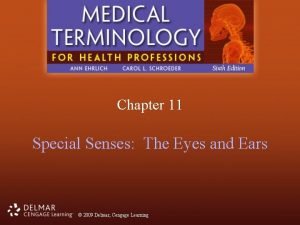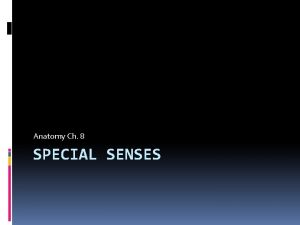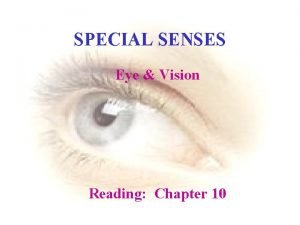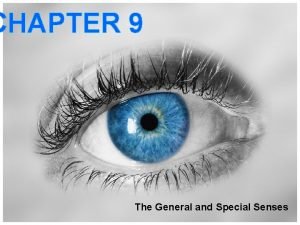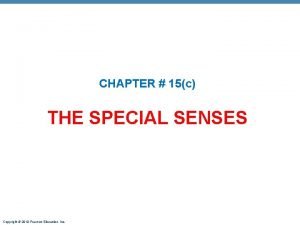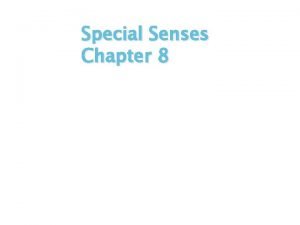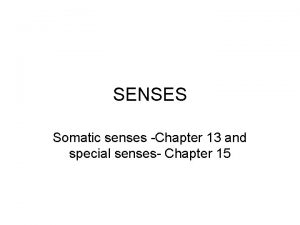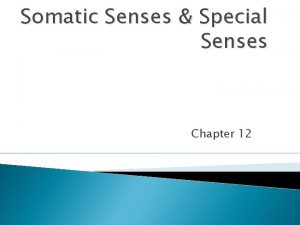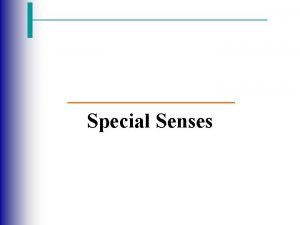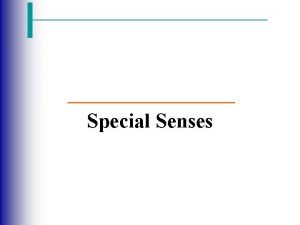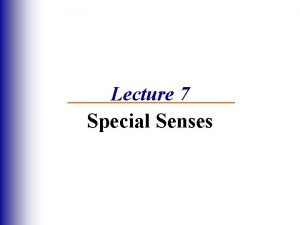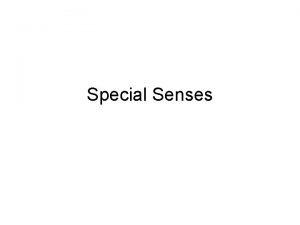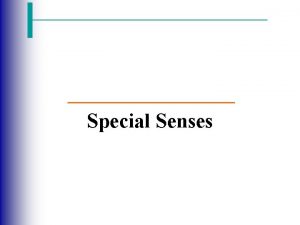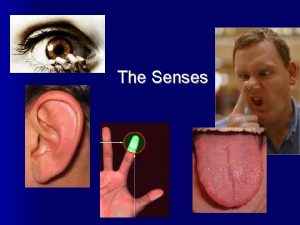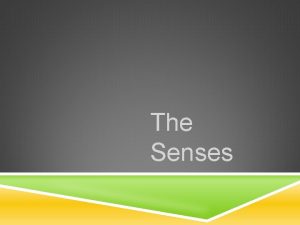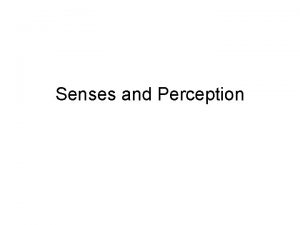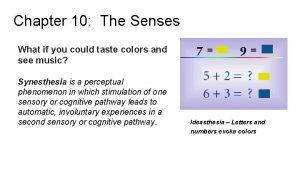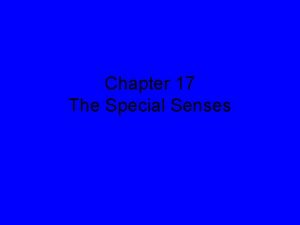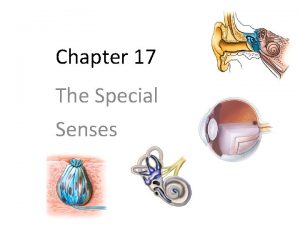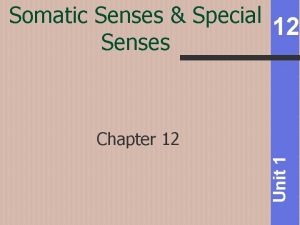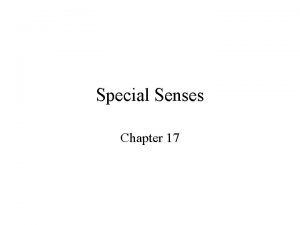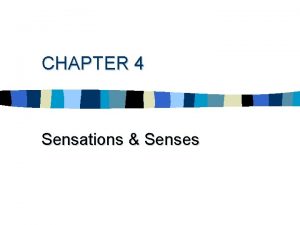Chapter 8 The Senses What if you could










































- Slides: 42

Chapter 8: The Senses What if you could taste colors and see music? Synesthesia is a perceptual phenomenon in which stimulation of one sensory or cognitive pathway leads to automatic, involuntary experiences in a second sensory or cognitive pathway. Ideasthesia – Letters and numbers evoke colors

General Senses = receptors found throughout the body, including joints and organs Special senses = specialized receptors found in the head (eyes, ears, mouth)

Types of Receptors 1. Chemoreceptors = chemical 2. Pain receptors = pain 3. Thermoreceptors = heat 4. Mechanoreceptors = pressure, location 5. Photoreceptors = light

Sensations Sensation = feeling that occurs when a brain interprets a sensory impulse Projection = process where the cerebral cortex causes a feeling to stem from a source (eyes, ears) Sensory adaptation = sensory receptors stop sending signals when they are repeatedly stimulated What do you think is going on in this picture? Sensory Deprivation is a technique initially used by neuro-psychiatrists designed to deliberately reduce or completely remove stimuli from one or all of the senses.

General Senses Exteroreceptive = detects changes in the body’s surface (touch, temperature, pain) Visceroreceptive = detects changes in the viscera (blood pressure) Proprioceptive = changes in muscles, tendons, and body positions

Sense of Pain Visceral Pain - occurs in visceral tissues such as heart, lungs, intestine Referred pain - feels as though it is coming from a different part (heart pain may be felt as pain in arm or shoulder) Acute Pain - originates from skin, usually stops when stimulus stops (needle prick) Chronic Pain - dull aching sensation


Use the universal pain assessment tool to assess the pain level for each event Stubbed toe Burn from stove Slamming finger in a door Paper cut Sprained ankle Sore throat Migraine .

The Rising Tide of Prescription Abuse 2. 6 million people nationwide now regularly use prescription pain pills for recreational purposes. Taken in small doses, painkillers produce feelings of euphoria with no hangover.

What is the responsibility of the government with regard to drug use and overdose? What strategies can reduce the number of overdose deaths?

Special Senses Olfactory (smell) Gustatory (taste) Hearing & Equilibrium Sight

Sense of Smell (Olfactory) Odor --> Receptor Cell --> Olfactory bulb --> Olfactory Tract --> LIMBIC SYSTEM Why do smells trigger memories?

Olfactory Bulb on Sheep Brain


Sense of Taste (Gustatory) Papillae = taste buds

Taste Sensations Sweet Sour Bitter Salty Savory (Umami) Imagine the taste of: Strawberries Cheetos Banana French Fries Chocolate

Umami - a savory taste, is one of the five basic tastes, together with sweet, sour, bitter and salty. A loanword from the Japanese umami can be translated "pleasant savory taste". Bacon, cheddar and beef all have umami, and together they “synergize the umami effect. ” Toss in sautéed mushrooms and you’ve struck an umami mother lode. Umami, he says, “alters our perception of other tastes, making salt, saltier, sweeter, and bitter and sour less biting. ” It is a taste that can’t be duplicated with any of the other four tastes.

Do we all experience taste in the same way? Genetics may play a role in whether you like certain foods. Does cilantro taste like soap to you?

Sense of Hearing External Ear Auricle (pinna) - outer ear Auditory Canal (external auditory meatus) - opening to the eardrum


Ear movement is common in many mammals, including cats, dogs and horses, and usually serves to swivel the ear towards the direction of a sound. A group of muscles called the auriculares are responsible for this movement. Ear wiggling is considered a VESTIGIAL trait - a trait that no longer functions but is part of our evolutionary past.


Middle Ear (tympanic cavity) Eardrum (tympanum) Auditory Ossicles - malleus, incus, stapes - transmit vibrations and amplify the signal malleus incus stapes Auditory Tube (eustachian tube) - connects the middle ear to the throat - helps maintain air pressure

Why do children get tubes put in their ears?

Inner Ear Labyrinth - communicating chambers and tubes

Inner Ear Semicircular Canals - sense of equilibrium Cochlea - sense or hearing Organ of Corti - contains hearing receptors, hair cells detect vibrations

Why do we lose our hearing? Inside the cochlea are special neurons called HAIR CELLS. Loud noises damage these fibers. As you age, hair cells become damaged (loud music can speed this process along). Older people usually can’t hear frequencies that younger people can hear. Try the hearing test!

stereocilia


Steps in Hearing 1. Sound waves enter external auditory canal 2. Eardrum vibrates 3. Auditory ossicles (malleus, incus, stapes) amplify vibrations 4. Stapes hits oval window and transmits vibrations to cochlea 5. Organs of corti contain receptor cells (hair cells) that deform from vibrations 6. Impulses sent to the vestibulocochlear nerve 7. Auditory cortex of the temporal lobe interprets sensory impulses 8. Round window dissipates vibrations within the cochlea

EXTERNAL MIDDLE INNER

Malleus, Incus, Stapes Vestibulocochlear nerve Tympanic Cavity Color the structures of the ear.

Cochlear Implants A cochlear implant receives sound from the outside environment, processes it, and sends small electric currents near the auditory nerve. The brain learns to recognize this signal and the person experiences this as "hearing". 8 month old reacts to cochlear implant


Sense of Equilibrium Static Equilibrium - maintain stability and posture Dynamic Equilibrium - balance during sudden movement Cerebellum - interprets impulses from the semicircular canals and maintains overall balance Walking on two legs is harder than you think… Robot Fails

OTOSCOPE Otolaryngology (pronounced oh/toe/lair/in/goll/oh/jee) Otolaryngologists are physicians trained in the medical and surgical management and treatment of patients with diseases and disorders of the ear, nose, throat (ENT), and related structures of the head and neck. They are commonly referred to as ENT physicians.

Disorders of Sensory Systems 1. Synesthesia 2. Anosmia 3. Tinnitus 4. Anhidrosis (inability to sweat) 5. Congenital Analgesia (CIP) Mutations in genes prevents nerve impulses from pain receptors (nociceptors) from sending signals to the brain.

Hereditary (Congenital) Deafness Occurs in 1 of every 1000 to 2000 newborns Syndromic Pendred Syndrome Usher Syndrome A SYNDROME is a disease that has more than one feature or symptom. A person with Usher syndrome also has vision problems

Hereditary (Congenital) Deafness Non-syndromic A specific mutation results in hearing loss; can be recessive (80%) or dominant (20%). Recessive inheritance, can you identify the “carriers? ”

Deafness can also be caused by PRENATAL Infections from “To. RCH” organisms Toxoplasmosis Rubella Cytomegalovirus (CMV) Herpes Postnatal infections can also cause deafness Meningitis Streptococcus Listeria Influenza

Presbycusis = age related hearing loss -diminished hearing sensitivity -poor speech comprehension in noisy environments -slowed central processing of acoustic information -high frequencies are more difficult to hear Fun Fact: Many vertebrates such as fish, birds and amphibians do not suffer presbycusis in old age as they are able to regenerate their cochlear sensory cells, whereas mammals including humans have lost this regenerative ability. It is estimated that 30 -40% of people over the age of 65 have presbycusis

Careers Related to Hearing Audiologist Speech-Language Pathologist Sign Language Interpreter Teacher: Deaf & Hearing Impaired
 What is the difference between somatic and special senses
What is the difference between somatic and special senses Special vs general senses
Special vs general senses You were the word in the beginning
You were the word in the beginning If i could only teach you one thing why god made you
If i could only teach you one thing why god made you Major prophets
Major prophets If you could be invisible what would you do and why?
If you could be invisible what would you do and why? My 3 wishes
My 3 wishes Thermoreceptors
Thermoreceptors Chapter 17 special senses answer key
Chapter 17 special senses answer key Learning exercises chapter 11 medical terminology
Learning exercises chapter 11 medical terminology Anatomy and physiology chapter 8 special senses
Anatomy and physiology chapter 8 special senses Chapter 8 special senses
Chapter 8 special senses Emmentropia
Emmentropia The general and special senses chapter 9
The general and special senses chapter 9 Olfactory receptor cells
Olfactory receptor cells Chapter 15 special senses
Chapter 15 special senses Wnhen
Wnhen Hình ảnh bộ gõ cơ thể búng tay
Hình ảnh bộ gõ cơ thể búng tay Bổ thể
Bổ thể Tỉ lệ cơ thể trẻ em
Tỉ lệ cơ thể trẻ em Chó sói
Chó sói Glasgow thang điểm
Glasgow thang điểm Bài hát chúa yêu trần thế alleluia
Bài hát chúa yêu trần thế alleluia Các môn thể thao bắt đầu bằng từ đua
Các môn thể thao bắt đầu bằng từ đua Thế nào là hệ số cao nhất
Thế nào là hệ số cao nhất Các châu lục và đại dương trên thế giới
Các châu lục và đại dương trên thế giới Cong thức tính động năng
Cong thức tính động năng Trời xanh đây là của chúng ta thể thơ
Trời xanh đây là của chúng ta thể thơ Mật thư tọa độ 5x5
Mật thư tọa độ 5x5 101012 bằng
101012 bằng độ dài liên kết
độ dài liên kết Các châu lục và đại dương trên thế giới
Các châu lục và đại dương trên thế giới Thơ thất ngôn tứ tuyệt đường luật
Thơ thất ngôn tứ tuyệt đường luật Quá trình desamine hóa có thể tạo ra
Quá trình desamine hóa có thể tạo ra Một số thể thơ truyền thống
Một số thể thơ truyền thống Bàn tay mà dây bẩn
Bàn tay mà dây bẩn Vẽ hình chiếu vuông góc của vật thể sau
Vẽ hình chiếu vuông góc của vật thể sau Biện pháp chống mỏi cơ
Biện pháp chống mỏi cơ đặc điểm cơ thể của người tối cổ
đặc điểm cơ thể của người tối cổ Ví dụ về giọng cùng tên
Ví dụ về giọng cùng tên Vẽ hình chiếu đứng bằng cạnh của vật thể
Vẽ hình chiếu đứng bằng cạnh của vật thể Tia chieu sa te
Tia chieu sa te







